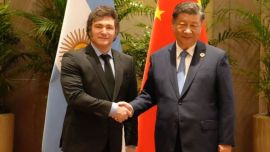For once Argentina has joined a global trend with plenty of experience in hand – inflation and economic instability figure as public enemy number one for the world economy.
Last month’s cost-of-living figure for the country of 7.4 percent is around average for OECD countries – but for the entire year ( Germany posted 7.4 percent last month as an annual figure, for example). In Argentina annual inflation measured 71 percent but is already projected to reach 92 percent in 2022 just by repeating in the last five months of the year the average of the first seven – 5.6 percent.
Of course, that might prove optimistic – what remains of the year could resemble more its first third, which would relieve the pressure on the government on the threshold of an electoral year but could also mirror the last two months, thus crossing the barrier of three-digit annual inflation with ease.
Guilty
In any case there is a consensus in Argentina that two factors above all have pushed inflation to its highest levels in four decades – the energy price shock accelerated by the Russian invasion of Ukraine and the monetary tsunami with which all countries tried to compensate for the fall of productive activity during the painful years of the Covid-19 pandemic.
The panorama was boosted in Argentina by the serious imbalances with which the economy entered the pandemic and the restrictions with which the ruling coalition hems in economic policy.
Only in a fifth of the last 75 years in Argentina has there been single-digit annual inflation. The country has also experienced 22 years of recession since 1960 (or 36 percent of the total), according to World Bank data. Per capita income has practically stood still in the last two decades with zero growth since 2012 as against the “Chinese growth rates” of the post-convertibility years.
Throughout recent history, or at least the last half-century, the inflationary scourge has been accompanied by initiatives to slow its drive with more defeats than victories along the way. President Alberto Fernández’s bombastic declaration of a “war” against inflation last March soon turned into one more frustration in this saga of diagonal moves trying to control it without resorting to austerity.
Magic steps
The strategies ranged from the “meatless” price indices of the 1970s when beef was an essential product in the family shopping-basket, the “patriotic” fiddling of the INDEC national statistics bureau’s figures when under the trusteeship of Guillermo Moreno, exchange rate controls to ensure a cheap dollar, export and import restrictions to guarantee food supplies at subsidised prices and holding down public service billing, just to mention some of the attempts to control the inevitable. An unsustainable effort to straitjacket the economy into normality.
For IDESA economist Jorge Colina, the reason for this persistence is that in all governments (Peronist, Radical, coalition or even the military) “far from any grieta differences, there was a robust consensus – that the state should spend beyond its means. And that was chronically financed by running up debt or printing money and that’s why we’ve had recurrent inflation.”
The fiscal deficit was another characteristic of the Argentine economy but that goes back to the dawn of independence. Something always needed plugging, whether through war, internal conflicts or difficult access to revenue – something similar to what happened in the rest of the region although that is now in the process of revision.
Even Venezuela’s maverick Bolivarian regime is converging towards the inflation rates of the rest of its neighbours – last year’s annual rate was 137 percent but the cumulative rate since January is 48 percent. Only two points thus separate the Argentine economy from the baleful prophesy that it is turning “Venezuelan” (46 percent so far this year, according to INDEC).
In the judgement of Eduardo Levy Yeyati, dean of the School of Government at Di Tella University: “Latin America has learned to hate inflation (and to contain it) because it has come to understand that it creates poverty (and topples governments) so that few would now recognise it as the other side of the coin to many of the benefits demanded from the state (subsidies, a cheap dollar and low interest rates, protectionism and transfers of unbacked money).”
Plans
In Argentina, few of the stabilisation plans implemented have lasted and they ended up imploding due to their intrinsic weakness.
The Ber Gelbard plan of “zero inflation” ended two years later in the explosion of the “Rodrigazo” (1975). The Austral Plan was perhaps the first to try and tame the inflationary dragon with an integral approach (the removal of index-linking, exchange rate controls and a general modification of expectations) but it ended up succumbing to a lack of fiscal coordination and trade union harassment, returning after four years to high inflation with a brief spell of hyperinflation in 1989.
The other lasting plan was convertibility (1991-2001) – still under discussion due to its secondary effects and the conditions it faced. Economist Juan José Llach, deputy economy minister in the early stages of the plan, analyses the roots of interminable inflation: “Trying from the government to validate the consumer ambitions of the populace without accompanying them with suitable incentives for production.”
According to his viewpoint, the case studies which should serve as models are Spain in the 1970s, Israel in the 1980s, Chile in the 1990s and South Africa in this century.
“What they had in common was reaching agreements to maximise price stability, reducing consumption in the present in order to maximise it in the medium and long term,” he underlines. And these examples make him think that a sustained reduction of inflation in Argentina would be very difficult without minimal agreements leading to fiscal (and also in this framework monetary) discipline.
No magic, it would seem, but neither is it a recipe for economic technocracy.
Professor Alicia Caballero, a former Economics dean at the UCA Catholic University explains the inability to accept limits, reflecting: “Budget restriction has its limits. The ‘no’ always ends up being a ‘perhaps’ or ‘that depends’ … individually we think that we have more rights than obligations and that while goods carry their costs, they should not have a price.”
Levy Yeyati observes with concern the festival of euphemisms to disguise updating public service pricing, concluding: “I do not see much demand for reduced subsidies. On the contrary, many are speaking of this marginal trim as a tarifazo. But nor do I see much demand for pension reform or the reduction of exemptions.”
The battle against inflation is difficult but the war is almost a mission impossible in this context.




















Comments